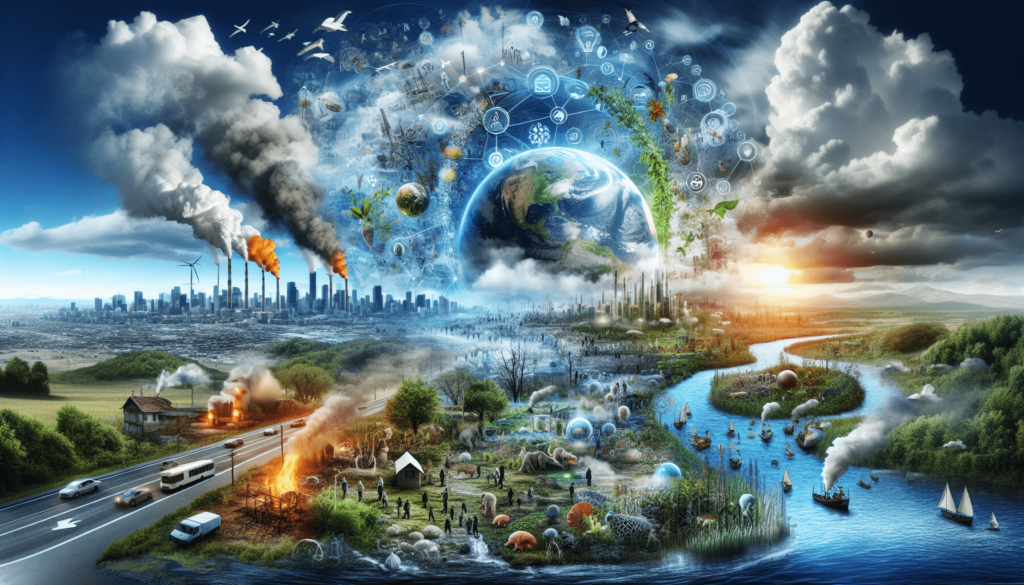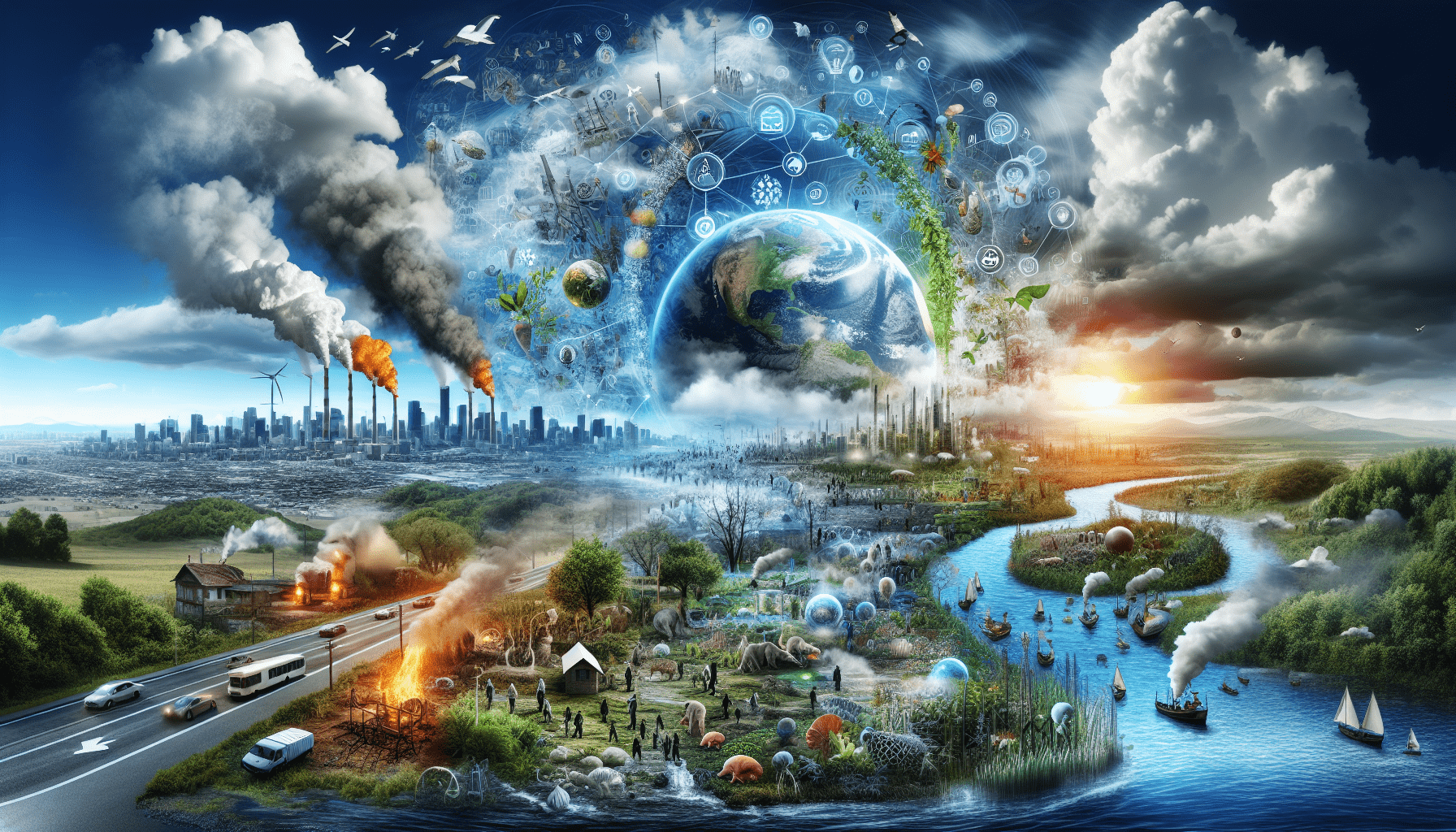Ladies and gentlemen, gather ’round, for we have an intriguing topic to discuss today! Brace yourselves as we embark on an exploration of the enigmatic concept known as climate change. What exactly is this phenomenon that holds the world’s attention captive? In this article, we will unravel the intricacies of climate change, shedding light on its causes, effects, and the imperative need to address it. Get ready to unlock the secrets of this global challenge and understand why it has become a pressing concern for all of us.

Definition of Climate Change
The concept of climate change
Climate change refers to the long-term alteration in weather patterns and average temperatures on Earth. It encompasses shifts in temperature, precipitation, wind patterns, and other elements of climate. These changes can occur over decades or centuries and can have profound effects on ecosystems, human societies, and the overall well-being of the planet.
Changes in temperature and weather patterns
One of the key aspects of climate change is the alteration in temperature and weather patterns. This includes both overall warming trends and changes in regional and seasonal temperatures. These shifts can lead to greater frequency and intensity of heatwaves, as well as changes in precipitation patterns, such as increased rainfall in some regions and more prolonged droughts in others.
Long-term shifts in climate
Climate change is characterized by long-term shifts in climate conditions. This differs from short-term weather variations, which can fluctuate daily or seasonally. The gradual changes associated with climate change can have far-reaching consequences, impacting ecosystems, natural resources, agriculture, and human activities. These shifts can persist for decades or even centuries, making them a critical concern for the present and future generations.
Causes of Climate Change
Greenhouse effect
One of the primary causes of climate change is the greenhouse effect. Certain gases, such as carbon dioxide (CO2), methane (CH4), and nitrous oxide (N2O), trap heat in the Earth’s atmosphere. This trapped heat leads to a warming effect on the planet’s surface, similar to how a greenhouse traps heat for plant growth. However, human activities have significantly increased the concentration of these greenhouse gases through the burning of fossil fuels, deforestation, and industrial processes.
Human activities
Human activities are major contributors to climate change. The burning of fossil fuels for energy production and transportation releases significant amounts of greenhouse gases, especially carbon dioxide, into the atmosphere. Deforestation, particularly in tropical regions, also contributes to climate change by reducing the Earth’s capacity to absorb and store carbon dioxide. Additionally, industrial processes and agricultural practices, such as livestock production, release methane and nitrous oxide, further exacerbating the problem.
Natural factors
While human activities play a crucial role in climate change, natural factors also contribute to the phenomenon. Variation in solar radiation, volcanic eruptions, and natural fluctuations in greenhouse gas concentrations are among the natural causes of climate change. However, the current rate and extent of climate change are primarily driven by human influences, making it vital to address our impact on the environment.
Impact of Climate Change
Global warming
Climate change leads to global warming, where the average temperature of the Earth’s surface increases. This warming can have extensive consequences, such as the melting of ice caps and glaciers, rising sea levels, and more frequent extreme weather events. Global warming disrupts ecosystems, weather patterns, and the delicate balance that sustains life on our planet.
Rising sea levels
One of the most significant impacts of climate change is the rising sea levels. As global temperatures increase, glaciers and ice caps melt, adding water to the world’s oceans. This phenomenon threatens coastal communities, low-lying islands, and vital ecosystems. Rising sea levels can lead to increased coastal erosion, flooding, loss of land, and salinization of freshwater sources.
Extreme weather events
Climate change is responsible for the increased frequency and intensity of extreme weather events. Heatwaves, hurricanes, droughts, floods, and wildfires have become more frequent and severe in various regions around the world. These events have devastating consequences for communities, infrastructure, agriculture, and natural resources, leading to loss of life, displacement, and economic hardship.
Changes in ecosystems
Climate change disrupts ecosystems by altering temperature and precipitation patterns, affecting the distribution and behavior of plant and animal species. As temperatures rise and habitats change, some species may struggle to adapt or find suitable conditions for survival. This can result in population declines, shifts in species ranges, and potential loss of biodiversity. Changes in ecosystems can also impact the availability of resources for human societies, such as food and water.
Health consequences
The impacts of climate change extend to human health. Rising temperatures can lead to increased heat-related illnesses, such as heat stroke and exhaustion. Changes in weather patterns may also contribute to the spread of diseases, as different regions become more or less favorable for disease-carrying organisms. Additionally, air pollution levels can worsen due to increased heat and changing atmospheric conditions, leading to respiratory problems and cardiovascular diseases. Climate change can also affect food and water availability, potentially causing malnutrition and waterborne diseases.
Evidence of Climate Change
Temperature records
Temperature records from around the world consistently show a long-term warming trend. Scientists use data collected from weather stations, satellites, and other sources to analyze and track changes in average global temperatures. These records provide compelling evidence that climate change is occurring and show that the Earth’s average temperature has risen significantly in recent decades.
Melting ice and glaciers
The melting of ice and glaciers is a visible and undeniable sign of climate change. Glacier retreat and the loss of ice from polar regions contribute to rising sea levels. Satellite imagery and field observations confirm the steady decline in the size and thickness of ice masses. The loss of ice has far-reaching consequences for ecosystems, wildlife, and the availability of freshwater resources.
Rising ocean temperatures
Sea surface temperatures have been steadily rising due to climate change. Warming oceans have implications for oceanic ecosystems, including coral reefs, which are highly sensitive to temperature changes. Increased ocean temperatures can lead to coral bleaching, where corals expel their symbiotic algae, causing them to turn white and become more susceptible to disease and death. The impact of rising ocean temperatures extends beyond marine ecosystems, affecting weather patterns and the functioning of the Earth’s climate system.
Altered precipitation patterns
Changes in precipitation patterns are another piece of evidence for climate change. Shifts in rainfall amounts and distribution, as well as changes in snowfall patterns, have been observed in various regions. Some areas experience more intense rainfall events, leading to an increased risk of flooding, while others face more prolonged periods of drought. These alterations in precipitation patterns have implications for agriculture, water availability, and the overall resilience of ecosystems and human societies.
Shifting species ranges
Climate change has caused shifts in the ranges of many plant and animal species. As temperatures change, species may move towards more suitable habitats in search of suitable conditions for survival and reproduction. Scientists have documented these shifts in species ranges, with many species moving towards the poles or to higher elevations. These shifts can disrupt ecological interactions, impact the composition and functioning of ecosystems, and potentially lead to the extinction of certain species unable to adapt to the changing conditions.
Effects of Climate Change on Weather Patterns
Changes in rainfall
Climate change can cause alterations in rainfall patterns, leading to both increased and decreased precipitation in different regions. Some areas may experience heavier rainfall and an increased risk of flooding, while others may face prolonged periods of drought. Changes in rainfall patterns can have significant implications for agriculture, water resources, and the overall stability of ecosystems.
Droughts
As global temperatures rise, droughts become more frequent and severe in certain regions. Droughts can lead to water scarcity, crop failures, and livestock losses, affecting food production and livelihoods. Prolonged droughts can also increase the risk of wildfires and cause further stress on ecosystems and natural resources.
Heatwaves
Climate change contributes to more frequent and intense heatwaves. Heatwaves can have severe consequences for human health, especially for vulnerable populations such as the elderly, children, and those with pre-existing health conditions. Heatwaves can also impact agriculture, infrastructure, and energy demand, posing challenges for societies and economies.
More intense storms
Warmer temperatures can lead to more energy in the atmosphere, increasing the intensity of storms. This includes hurricanes, cyclones, and typhoons, which can cause widespread damage and loss of life. More intense storms can also result in extreme rainfall and flooding, further exacerbating the impacts of climate change on communities and ecosystems.
Changes in seasonal patterns
Climate change can disrupt traditional seasonal patterns. Shifts in temperatures and precipitation can alter the timing of seasons, affecting the timing of plant growth, animal migrations, and other ecological processes. These changes can have cascading effects throughout ecosystems, impacting species interactions, food availability, and ecosystem services.
Consequences for Natural Systems and Biodiversity
Loss of habitat
Climate change poses a significant threat to natural habitats. As temperature, precipitation, and other climate factors change, the suitability of habitats for certain species may be altered. This can lead to habitat loss, as species struggle to adapt and find suitable conditions for survival. Habitat loss can have cascading impacts on biodiversity, with potential consequences for overall ecosystem functioning and the ability of natural systems to provide essential services.
Species extinction
Climate change is a major driver of species extinction. As habitats change or become inaccessible, some species may not be able to adapt quickly enough to survive. Increased temperatures can also directly impact certain species, causing physiological stress and reducing reproductive success. The loss of species can disrupt ecological balance, lead to the loss of functional diversity, and have profound consequences for ecosystems and human societies.
Disruption of ecological balance
The interconnectedness of ecosystems means that changes in one species or part of an ecosystem can have cascading effects on others. Climate change disrupts ecological balance by altering the timing of natural events, such as the blooming of flowers or the emergence of insects. These disruptions can impact pollination, seed dispersal, and predator-prey relationships, leading to imbalances and potential ecosystem collapse.
Altered migration patterns
Many species rely on seasonal migrations to access appropriate habitats and resources. Climate change can disrupt these migration patterns by altering the timing of the seasons or changing the conditions in different regions. As a result, some species may be unable to complete their annual migrations, leading to population declines and potential ecosystem disruptions.
Impacts on Human Health
Increased heat-related illnesses
As global temperatures rise, the frequency and intensity of heatwaves increase, posing serious health risks. Heat-related illnesses, such as heatstroke and heat exhaustion, become more prevalent, particularly in urban areas with a lack of green spaces and limited access to cooling measures. Vulnerable populations, including the elderly, children, and individuals with pre-existing health conditions, face the greatest risks.
Spread of diseases
Climate change can impact the spread of diseases, as shifts in temperature and precipitation create favorable conditions for disease-carrying organisms. Mosquito-borne diseases, such as malaria, dengue fever, and Zika virus, are particularly affected. Warmer temperatures expand the geographical range of mosquitoes, increasing the exposure of populations to these diseases. Changes in rainfall patterns can also create conditions suitable for waterborne and vector-borne diseases to proliferate.
Air pollution-related problems
Climate change exacerbates air pollution problems, leading to respiratory and cardiovascular health issues. Higher temperatures can increase the formation of ground-level ozone, a harmful air pollutant that can cause or worsen respiratory problems, particularly for individuals with pre-existing respiratory conditions. Increased wildfires, which are often linked to climate change, can also release unhealthy air pollutants and exacerbate respiratory issues.
Food and water scarcity
Climate change can impact food and water availability, leading to potential scarcity. Changes in precipitation patterns can result in crop failures, reduced yields, and decreased water availability for irrigation. This can lead to food price increases, malnutrition, and potential conflicts over water resources. Additionally, extreme weather events, such as floods and droughts, can damage infrastructure, disrupt food distribution systems, and further contribute to food and water scarcity.
Mitigation and Adaptation Strategies
Reducing greenhouse gas emissions
One of the key strategies to combat climate change is to reduce greenhouse gas emissions. This involves transitioning to cleaner energy sources, improving energy efficiency, and promoting sustainable practices across sectors. By decreasing the reliance on fossil fuels and adopting renewable energy alternatives, emissions can be significantly reduced, contributing to the mitigation of climate change.
Renewable energy sources
The adoption of renewable energy sources, such as solar, wind, and hydroelectric power, is crucial in mitigating climate change. These renewable sources generate energy without emitting greenhouse gases and reduce the reliance on finite fossil fuel resources. Transitioning to renewable energy helps to decarbonize the economy and contributes to a more sustainable and low-carbon future.
Nature-based solutions
Nature-based solutions harness the power of nature to mitigate and adapt to climate change. This includes actions such as conserving and restoring ecosystems, reforestation, and sustainable land management. Nature-based solutions can sequester carbon dioxide from the atmosphere, enhance ecosystem services, and improve ecosystem resilience, helping to address climate change while providing multiple co-benefits for biodiversity and human well-being.
Climate-resilient infrastructure
Building climate-resilient infrastructure is essential for adapting to the effects of climate change. This involves constructing infrastructure that can withstand extreme weather events, rising sea levels, and changing climate conditions. Climate-resilient infrastructure is designed to minimize vulnerability, increase adaptive capacity, and ensure the continued functioning of essential services in the face of climate change impacts.
Education and awareness
Education and awareness play a vital role in addressing climate change. Increasing knowledge about climate change, its causes, and its impacts can empower individuals, communities, and organizations to take action. Education initiatives can promote sustainable practices, inform decision-making processes, and foster a global mindset that values the environment and recognizes the interconnectedness of human and natural systems.
International Efforts to Combat Climate Change
United Nations Framework Convention on Climate Change
The United Nations Framework Convention on Climate Change (UNFCCC) is an international treaty established in 1992 to address climate change. It aims to stabilize greenhouse gas concentrations in the atmosphere and prevent dangerous interference with the climate system. The UNFCCC provides the framework for international cooperation on climate change mitigation, adaptation, technology transfer, and financial support.
Paris Agreement
The Paris Agreement, adopted in 2015, is a landmark global agreement under the UNFCCC. It sets out long-term goals to limit global warming and strengthen global response to climate change. The agreement aims to keep the global temperature increase well below 2 degrees Celsius above pre-industrial levels and pursue efforts to limit the temperature increase to 1.5 degrees Celsius. It also outlines commitments for countries to enhance climate resilience, reduce greenhouse gas emissions, and provide financial and technological support to developing countries.
Intergovernmental Panel on Climate Change
The Intergovernmental Panel on Climate Change (IPCC) is a scientific body established by the UNFCCC. It provides policymakers with comprehensive assessments of climate change science, impacts, vulnerability, and mitigation options. The IPCC’s reports are based on the assessments of thousands of scientists from around the world and serve as a key reference for understanding the current state of climate change and informing policy decisions.
Renewable energy initiatives
Many countries and regions have implemented renewable energy initiatives to promote the transition to cleaner energy sources. These initiatives include the development of renewable energy targets, financial incentives, and regulatory frameworks to spur investment in renewable energy technologies. By fostering the deployment of renewable energy, countries can reduce greenhouse gas emissions, enhance energy security, and stimulate economic growth.
Green economy development
The concept of a green economy involves transforming economies to be more sustainable and low-carbon. This involves promoting green technologies, renewable energy, energy efficiency, and sustainable practices across sectors. Green economy development prioritizes sustainable development goals while addressing climate change challenges, creating opportunities for job creation, poverty reduction, and resilient communities.
Role of Individuals in Addressing Climate Change
Energy conservation
Individuals can contribute to addressing climate change by conserving energy in their daily lives. This includes actions such as using energy-efficient appliances, reducing unnecessary energy consumption, and optimizing heating and cooling practices. Energy conservation helps to reduce greenhouse gas emissions, save money on energy bills, and promote sustainable resource use.
Reducing carbon footprint
Reducing personal carbon footprints is another way individuals can make a positive impact on climate change. This involves minimizing activities that result in significant greenhouse gas emissions, such as driving alone in a car, excessive air travel, or consuming resource-intensive products. By adopting low-carbon alternatives, such as using public transportation, carpooling, cycling, or choosing energy-efficient products, individuals can reduce their environmental impact.
Sustainable lifestyle choices
Individuals can contribute to climate change mitigation by making sustainable lifestyle choices. These choices include opting for sustainable and ethically-produced products, reducing waste, practicing responsible consumption, and supporting local and organic food systems. Sustainable lifestyle choices promote a more environmentally conscious approach to daily living and contribute to a more sustainable and resilient future.
Supporting environmental organizations
Supporting environmental organizations can make a difference in addressing climate change. Individuals can contribute financially, volunteer their time, or actively participate in advocacy efforts. Environmental organizations play a crucial role in raising awareness, conducting research, implementing conservation projects, and advocating for policies that promote sustainability and climate action.
Advocacy and influencing policy
Individuals can advocate for climate change action by engaging in community initiatives, participating in public consultations, and contacting elected representatives. By actively voicing concerns and supporting policies that prioritize climate change mitigation and adaptation, individuals can influence decision-making processes at local, national, and international levels. Advocacy efforts can contribute to the development of policies and measures that align with the goals of the Paris Agreement and address the urgency of climate change.




